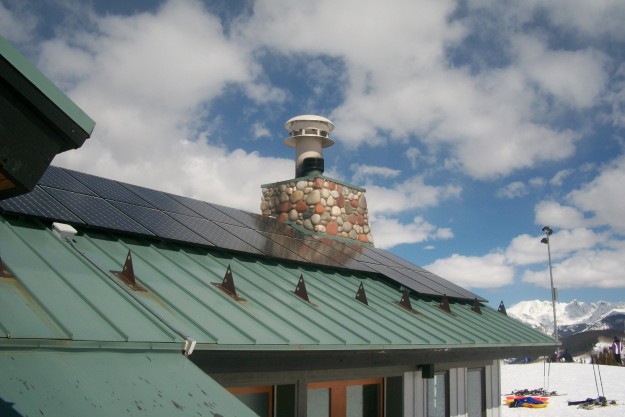Widgetized Section
Go to Admin » Appearance » Widgets » and move Gabfire Widget: Social into that MastheadOverlay zone
EPA to ‘vigorously defend’ Clean Power Plan against Colorado lawsuit
Editor’s note: A version of this story first appeared in The Colorado Statesman:
Colorado Attorney General Cynthia Coffman recently announced the state will join others in legally challenging the U.S. Environmental Protection Agency’s Clean Power Plan, eliciting promises of a “vigorous defense” by the EPA.
Coffman said in a press release that the EPA’s 111(d) rule, which would reduce carbon dioxide emissions from power plants 32 percent below 2005 levels by 2030, is “an unprecedented attempt to expand the federal government’s regulatory control over the state’s energy economy.”
Coffman’s lawsuit will be filed in the U.S. Court of Appeals in Washington, D.C. when the EPA publishes the rule – first issued on Aug. 3 — in the Federal Register. Coffman spokesman Roger Hudson said more details of her legal strategy will be available at that point.
“Attorney General Coffman believes the EPA is trying to fundamentally shift power from state government to the federal government, and that it is her job to stand up for Colorado’s rights and protect its place in the balance of power,” Hudson said in an email. “The future of Colorado’s resources should be decided by Coloradans — not by a flawed federal agency in Washington.”
EPA spokeswoman Enesta Jones countered that the Clean Power Plan, or section 111(d) of the Clean Air Act, is legally and technically sound following years of input from state and industry officials, energy regulators, health and environmental groups, and members of the public.
“To ensure that the Clean Power Plan’s significant health benefits and progress against climate change are delivered to all Americans, EPA and the Department of Justice will vigorously defend it in court,” Jones said in an email statement to The Colorado Statesman last week.
However, Coffman questions the legality of the CPP, which will compel states to reduce carbon emissions from power plants by improving their efficiency or replacing coal-fired electrical production with renewable energy sources or cleaner-burning natural gas.
“The EPA appears unwilling to accept limits set by Congress in the Clean Air Act and instead is pushing its agenda forward through regulatory rewrites that overreach its legal authority,” Coffman said.
Professor Mark Squillace of the University of Colorado Law School predicts the length of time and the care that the EPA took in promulgating the rule makes its eventual victory likely, even if it reaches the U.S. Supreme Court.
“It’s a Hail Mary for the plaintiffs to try to win this case, but the Supreme Court has been split for a long time over some of these issues, and if it ends up going all the way up to the Supreme Court I can imagine it would be a close vote,” said Squillace, who specializes in environmental, natural resources and water law.
In June of 2014, the U.S. Supreme Court ruled 7-2 that the EPA can regulate greenhouse gas emissions from stationary sources such as power plants — with some limitations — and in 2007 the high court ruled 5-4 that the EPA should have regulated new car emissions to curtail greenhouse gas emissions.
Given that the Supreme Court has twice ruled the EPA has the authority to regulate greenhouse gas emissions, Squillace says the plaintiffs may have to rely on procedural arguments at both the appellate level and in the Supreme Court if the case gets that far.
“Whether [CPP] is the proper way to regulate, whether it was arbitrary and capricious for the government to do it in this way, whether the record was adequate — there are all kinds of procedural arguments that the plaintiffs could make in this case that I suppose could lead to the court reversing a decision,” Squillace said.
Coffman also contends the CPP could adversely impact Colorado’s economy.
“The face of Colorado’s economy could be forever changed and that will be reflected in lost jobs, higher utility rates, and an altered energy industry,” she said.
Coffman’s critics say her pending lawsuit runs counter to the values of Colorado residents, who in 2004 became the first electorate in the United States to pass a renewable energy standard. That initial 10 percent RES for investor-owned utilities such as Xcel Energy, which provides power to roughly two-thirds of Colorado, was then twice expanded by the legislature to its current level of 30 percent renewable energy by the year 2020.
Member-owned rural electric co-ops, which essentially account for the other third of the state’s power, were required by the legislature in 2013 to reach a 20-percent RES by 2020.
“The irony is that Colorado is well positioned to meet the goals of the Clean Power Plan because of Colorado’s leadership on expanding renewable energy, energy efficiency and promoting a cleaner energy future,” Conservation Colorado Deputy Director Carrie Curtiss said in a release blasting Coffman’s plan to sue the EPA as “misguided.”
Coffman spokesman Hudson said the attorney general is not choosing sides in the debate over which sources of energy should provide power in Colorado, which in 2014 got 60.2 percent of its electricity from coal compared to 22.5 percent natural gas and 17.3 percent renewable sources, according to the U.S. Energy Information Administration.
“The legal questions at stake are neither political nor partisan,” Hudson said. “General Coffman remains committed to protecting all of our state’s natural resources from federal overreach.”
CU’s Squillace says it’s problematic that Attorney General Coffman is a Republican elected official whose agenda in some cases differs from that of Democratic Gov. John Hickenlooper, who seems inclined to support federal policies regarding the regulation of greenhouse gases.
“That’s a political problem that the state is essentially speaking out of both sides of its mouth on this,” Squillace said. “It would be better if we had a system that was more unified, and in many states the attorney general is appointed by the governor.”
Overall state policy since Democrat Bill Ritter’s administration starting in 2006 has favored the expansion of renewable energy resources and the phasing out of coal-fired power plants.
Laura Farris, the EPA’s climate change coordinator for Region 8 in Denver, said at a solar energy symposium in Edwards this summer that the CPP broke up the country in regions based on energy portfolios and set a 21-percent RES for the West by 2020.
“Colorado has positioned itself really well under the Clean Power Plan, not only to be at 21 percent but to go well beyond that, and then they can trade credits to these other states that are going to need them,” Farris said, pointing out that neighboring Utah currently only gets about 3 percent of its electrical power from renewable sources.
“There is so much momentum that has built up around the Clean Power Plan,” she added. “It could be the biggest thing that the Environmental Protection Agency has ever done, and I think it really has the power to create this clean-energy future that we all deserve to have.”
However, state Sen. Randy Baumgardner, a Republican whose northwest Colorado district includes some of the state’s most productive coal mines, argues the Obama administration is looking to shut down the coal industry no matter the costs.
“The bottom line is they hate coal,” he said in an interview earlier this summer. “They think that renewable energy is the only way that this country is ever going to survive, and you know what? We need all of it. We need renewables, but it’s not sustainable right now. We’ve got to have fossil fuels.”
David O. Williams
Latest posts by David O. Williams (see all)
- The O. Zone: Bold Colorado sports predictions for remainder of 2024 - November 18, 2024
- Lindsey Vonn set to rejoin U.S. Ski Team - November 14, 2024
- Rail company eyeing Eagle County service no longer involved in Utah oil train proposal - November 13, 2024




